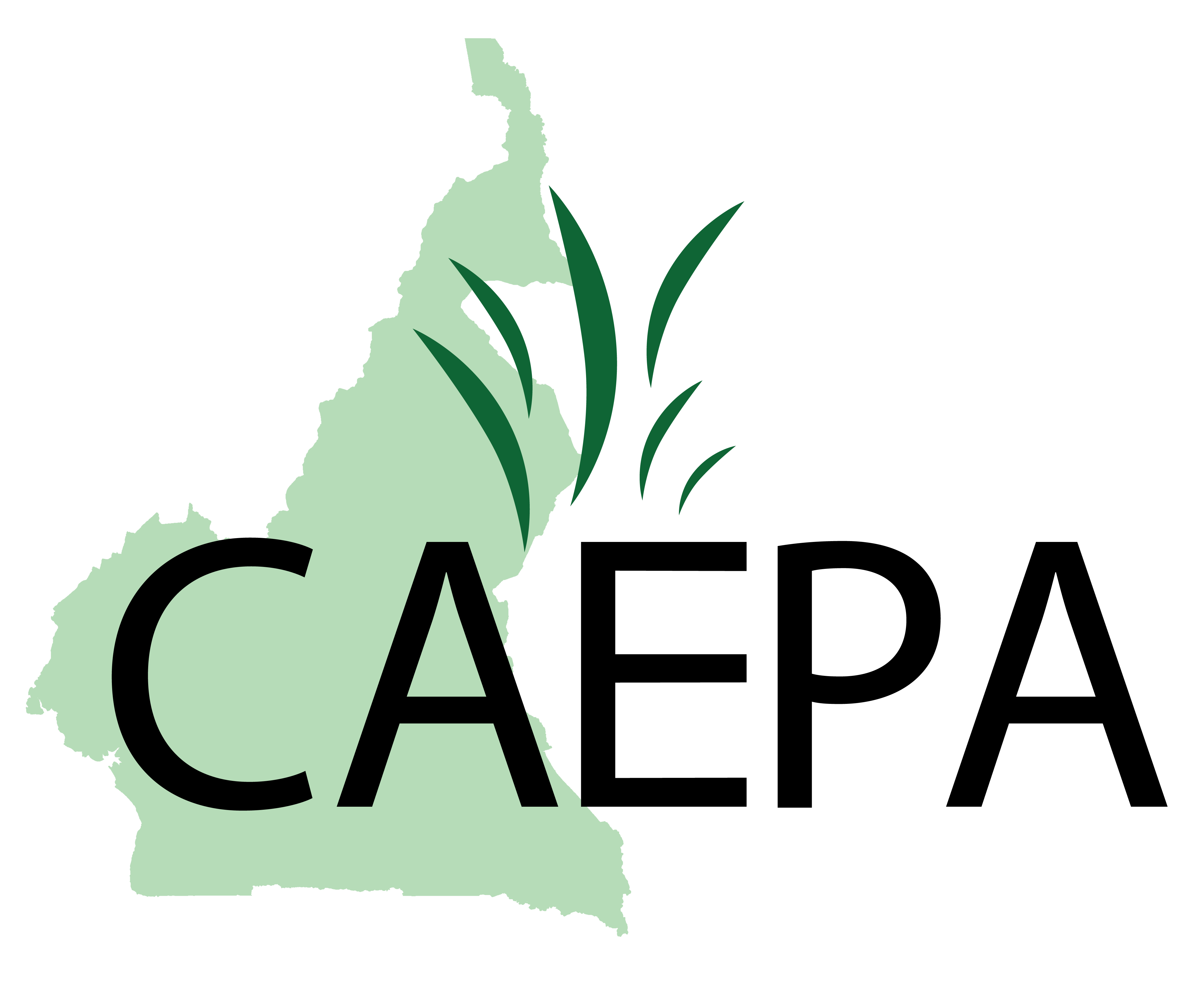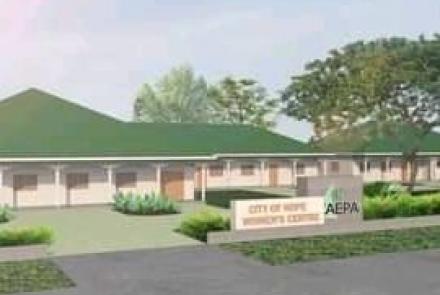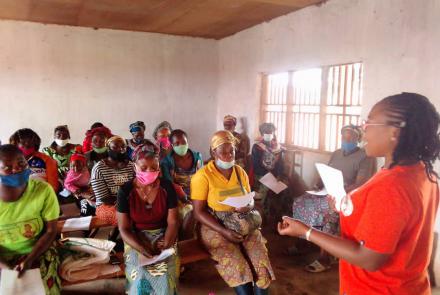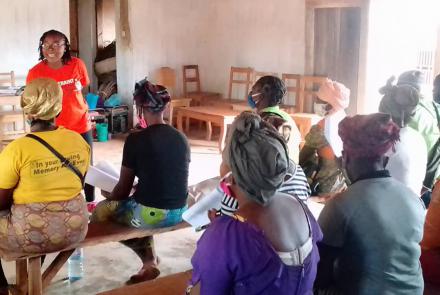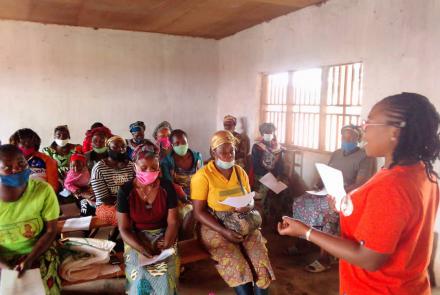Research and Policy
Survey: Early and Forced Marriages in the North-West Region
Following a survey carried out by CAEPA focused on early and forced marriages in the North-West region, a pilot program was put in place to give assistance to survivors seeking redress, therefore contributing to promoting the rule of law, ensuring the respect of social justice as well as equal opportunities, and enhancing the citizenship of women and girls of the Bali Chamba communities.
CAEPA also carried out several surveys on early and forced marriages and gender-based violence in the North West region of Cameroon and organised workshops to ensure development of local domestic violence strategies. Furthermore, round-table discussions on topics such as healthy relationships, sexual violence and consent, have resulted in VAW, media and internet, and promoted role models and champions to expose violence and raise awareness.
Survey: Gender-Based Violence (GBV) in the North West Region
In December 2018, CAEPA Cameroon conducted a survey of 320 women in the Balikumbat and Bamenda. It was reported that 100% of the women survey had been a victim of violence. The perpetrators were 90% husbands, boyfriends, and domestic spouses. All of the women also reported being abused by law enforcement officers, supervisors, and hooligans. In contrast, only 8 women reported the incidents to police, which is indicative of a significant distrust of law enforcement and deeply entrenched tradition. CAEPA will use the findings of the study to further raise awareness toward violence against women, as well as continue their numerous efforts in order to curb and eventually prevent gender-based violence from occurring.
Survey: Widowhood Rites and Practices in the Bali Chamba Region
CAEPA conducted a survey of 190 widows and ten traditional council members, ranging in age from 22 to 88. Out of 190 widows surveyed, all 100% stated that they had undergone widowhood rituals.
In Baligansin, one-third of the widows had been inherited – i.e. married to the deceased husband’s relative, 23% of the widows were in favour of abolition of widowhood rites, and none inherited property. In Baligashu, the ritual duration varied from three days to three months and there was zero widow inheritance, 100% of all widows were in favour of abolishing widowhood rites and over half inherited their deceased husband’s property.
CAEPA will use the findings of the study to continue to raise awareness toward widowhood rites and practices, as well as continue to offer workshops and work on legalizing marriages, and providing emotional support. Furthermore, CAEPA will remain an advocate toward making positive changes to the practice of widowhood rites, as well as specific rituals and ordeals.
Survey: The Impact of the Anglophone Conflict on the Population of Balikumbat Subdivision
CAEPA Cameroon did a survey about the experiences of 400 participants to identify the impact, needs and wants of the crisis. The participants were 50.2% female and were distributed around one third in each age group: 15 to 25 years, 26 to 45 years and 46 years and above.
The results reveal that 100% of the participants had been negatively impacted by the crisis. 38% of the sample responded that they had faced two or more challenges because of the crisis, going from loss of properties, loss of relatives or friends, to kidnappings. More than the 90% of participants in each village stated that their living conditions had worsened after the crisis. 56.5% of the respondents said that they had faced two or more challenges, including loss of property or displacement, unable to access a health provider, unemployment or unable to send a child to the school.
43% of the participants requested further intervention by international bodies. Other popular suggestions included negotiation of a cease-fire, with 29%, and access to workshop, seminars and capability building, mentioned by 17%.
Since the surveys focused on determining current sources of incomes for communities, the most common answers were business (provision), with 32%, and two or more sources, with 31.7%. To complete this picture, the survey also collected data about the desires to generate a more diverse income. The most common answer was business (provision), with 44.3%, followed by Sales of Farm Produce, with 24.8%.
It is also important to mention the perceived impacts to the communities as a whole. Only 107 participants stated that they have perceived an effect at this level, but it allowed observation of some trends. The most common answers were loss of lives, and poverty or hunger, with 23.3% of responses on both of them. Responses like no access to medical facilities, non-functioning schools and the loss of property were mentioned at least by 15%.
Bamenda Up-Station Hill Region
In 2009, the Global Network for Civil Society Organizations for Disaster Reduction (GNDR) established a program called ‘Views from the Frontline’ (VFL) to help stakeholders at risk in local communities, civil society and local government achieve a people-centred approach to resilience building. The VFL Program in 2019 continues to include and collaborate with ordinary residents, local governments and civil society and aims to strengthen systemic collaboration among government, at-risk people and civil societies. This survey analysis focused on the extent to which adverse events have affected these communities under review in the past five to ten years.
The VFL has adopted a policy designed to prevent social crises from escalation and target root causes. The neighbourhoods of Sisia II and Abangoh, located within the Bamenda up-station hill region, are an area at risk for adverse consequences of environmental, social and political crises. Social vices, such as tribalism, governmental impunity, conflict, crime, pollution and environmental degradation are rampant in this region due to pervasive threats of conflict, insecurity, lack of access to basic services, unemployment and climate change, among others.
To analyse adverse events affecting these communities, CAEPA supervised and collected data from surveys administered in Sisia II and Abangoh. A total of 75 questionnaires were administered: 10 for civil society organisations, 10 for local government actors, 5 for community consultants and 52 for random households. The surveys assessed frontline risks and related impacts facing the population.
The overall frontline assessment of community groups revealed that the greatest risk facing the respondents is landslides, with 24% of responses, followed by floods and pollution, both with 14.6% of respondents. The same question was posed to 10 members of civil society organisations, who cited the current most significant risks facing the community as landslides, floods and lack of access to water, and the most important priority areas as awareness-raising education, relocation and reforestation. This same group of respondents predicted that pollution, climate change and floods will be the greatest threats facing the younger generation.
Fifty-six individuals from community consultation groups were similarly surveyed. The greatest risks were seen differently among age and gender, with men citing flooding as most important, while women viewed climate change and youth viewed landslides as most critical. This group stated that the three most important community actions to mitigate risks are self-management, dam/dyke building and personal action. Interestingly, 86% of the women surveyed in this group stated that there has been an increase in disaster-based losses.
A group of local government representatives were interviewed, all of whom were males over the age of 35. This group cited the three most significant risks/threats to the community as landslides, floods and pollution. 80% of this group reported that changes in disaster losses over the past 5-10 years have slightly decreased. They also forecasted that the three most significant risks/threats that younger generations will face are climate change, landslides and floods.
Lastly, randomly selected households were similarly questioned and reported that 88% of them had been affected by adverse events (environmental, social, economic or political), for which they had to seek external help. Of this 88%, 34% cited climate change, 33% cited economic shock and 27% cited violence as the adverse events. The majority (48%) of the random households reported that they were able to recover on their own, while 33% reported needing help from extended family or friends.
As a result of this comprehensive survey, CAEPA was able to gather valuable information on the risks facing the Sisia II and Abangoh communities and the related consequences, barriers and priority action areas. CAEPA realised that even after ensuring anonymity, the participants showed extreme unwillingness to express their honest opinions, which reaffirmed the severity of their insecurity and fear. Socio-political concerns particularly impacted spontaneous responses, leading to hasty and neutral answers. Additionally, many of the participants did not consider their area to be a risk-zone, which is a direct cause of unpreparedness for potential adversity. Pollution, climate change and flooding were repeatedly referenced as the main threats to the communities in this region.
CAEPA will use the information gleaned from these surveys when devising relevant future programming and service provision in the Bamenda up-station hill region, particularly in relation to climate change and environmental protection. CAEPA would like to thank the Global Network for Civil Society Organizations for Disaster Reduction for implementing the VLF programme to increase inclusion and collaboration in community monitoring.
VLF Mankon Town Region
As an offshoot of the ‘Views from the Frontline’ (VFL) program, established by The Global Network for Civil Society Organizations for Disaster Reduction, CAEPA participated in a 2019 VLF-issued survey in the Mankon Town Region in North-West Cameroon. The aim of the study was to assess the environmental threats/risks and their impacts on the community inhabitants in the Mankon Town area, located in the Bamenda I region. CAEPA carried out the administration and collection of data from the survey to support the VLF program in evaluating frontline risks and implementing community programming to combat adverse events.
A total of 97 questionnaires were administered across four distinct social groups: Civil Society, Local Government, Community Consultants and Random Households. Each group was asked to identify the significant consequences that risks/threats have on their communities; which three priority actions the communities can take against the risks/threats; and which three most significant barriers to action are being implemented.
Ten civilians associated with Civil Society Organisations were interviewed one-on-one and reported that the most significant threats facing the community were floods, landslides and violence. This group forecasted that the three most significant risks/threats younger generations will face are pollution, climate change and unemployment.
The surveys in the Community Consultations group included 63 individuals across five social groups: children and youth, women, men, the elderly and persons with disability. They cited the three most significant risks as floods, pollution and violence. They forecasted that unemployment, disease/epidemics and the impacts of climate change (crop damage, desertification, floods and food insecurity) would significantly threaten younger generations as they grow up.
The Local Government group of 10 people was interviewed one-on-one and was inclusive of enumerators, community heads or people from different government services. They stated that the three most significant risks/threats that the community faces were floods, climate change and pollution. 70% of this group reported that changes in disaster losses over the past 5-10 years have increased and 30% of this group reported that the change in disaster losses has increased significantly. This group forecasted that the three most significant risks/threats that the younger generations will face when they grow up are unemployment, climate change and floods.
Lastly, the Randomly Selected Households group of 72 individuals was interviewed one-on-one. Only 56% of the surveyed group agreed that there had been community-led interventions in the community to reduce disaster risk. Interestingly, 92% of this group stated that they had been affected by adverse events that made them ask for external help to fully recover, with 31% stating economic shock and 30% stating climate change as the drivers. The majority of the random households that recorded responses (42%) recovered with the assistance from family or friends, 24% reported recovering on their own and 18% recovered with NGO assistance.
As a result of this comprehensive VLF survey, CAEPA was able to gather valuable information on the risks facing the Mankon Town communities and the related consequences, barriers and priority action areas. Through gathering the responses, CAEPA became aware that the participants showed extreme unwillingness when expressing their honest opinion, which reaffirmed the severity of their insecurity. The socio-political concerns as well as education status of the respondents posed difficulties in generating authentic and spontaneous answers from the participants.
CAEPA will use the information gleaned from these surveys when devising relevant future programming and service provision in the Mankon Town region, particularly in relation to climate change and environmental protection. CAEPA would like to thank the Global Network for Civil Society Organizations for Disaster Reduction for implementing the VLF programme to increase inclusion and collaboration in community monitoring.
